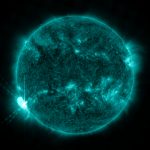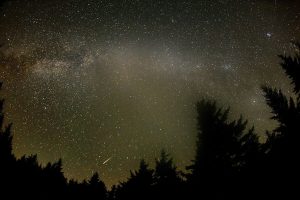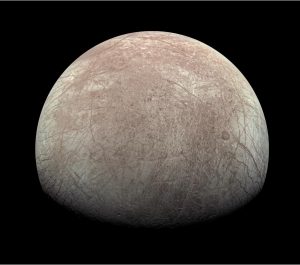
Global Space News: Ancient galaxy candidate
It has been a record breaking year for discovering ancient celestial objects. In the last two months, the Hubble Space Telescope has detected both a star and a rapidly growing black hole that existed when our Universe was less than a billion years old. Then at the start of April, a candidate for the oldest galaxy ever observed was announced in two international astronomy journals.

It is the finite speed of light that allows us to see the stars and galaxies of a much younger Universe. Because light needs time to reach us, it can take billions of years for the light from very distant objects to cross the astronomical distances to our telescopes. The resultant image is therefore not of the object as it is now, but of the object when that light was emitted long ago in the past. The light from the galaxy candidate HD1 is thought to have been travelling for a staggering 13.5 billion years, creating an image of a galaxy that existed in the Universe just 300 million years after the Big Bang.
Currently, it is not known if HD1 is definitely an ancient galaxy, or actually a closer object whose light appears to have travelled a greater distance. Nakagawa Takao in the Department of Space Astronomy and Astrophysics says that clues to the true nature of HD1 will come from observations of the galaxy candidate at different wavelengths of light. This will be greatly aided by upcoming space telescopes.
The detection of sources only in the infrared, with the non-detection in the optical bands, will be a key feature if this intriguing candidate is truly a high-redshifted galaxy. On the basis of this notable discovery, the authors (Harikane et al) clearly highlight the importance of the future missions we plan in Japan, including the optical & infrared Roman Space Telescope, in which Japan participates, and the infrared astronomy mission GREX-PLUX, which Japan leads.
Nakagawa Takao, Department of Space Astronomy and Astrophysics
It is not only the galaxy’s age that makes this discovery interesting. HD1 is strongly emitting ultraviolet light, which requires a particularly energetic source. One possibility is that the ancient galaxy is forming stars at an incredible rate. This option–explains Yamaguchi Hiroya, Department of Space Astronomy and Astrophysics–would help understand how the Universe became enriched with its plethora of chemical elements. At the beginning of the Universe, only the lightest elements existed, with heavier elements such as carbon, oxygen, silicon and iron forming in the nuclear furnace interiors of stars which then spilled out into the surrounding space. But the exact mechanics of how this production occurred remain unclear. To probe this further, Yamaguchi is interested in observing the even more energetic X-rays.
Very interesting results; the reported detection of a galaxy candidate in the earliest Universe. I’m very interested in the suggestion that, if the object is truly a galaxy, its star formation rate is extremely high and the fraction of massive stars is much higher in this object than in typical star-forming galaxies in the more recent Universe.
The JAXA-led mission XRISM (to be launched in this fiscal year) and the ESA-led Athena mission (to be launched in 2030s; JAXA also participates) will reveal the detailed star formation history by investigating the elemental composition and distribution in galaxy clusters. This will tell us how our Universe has been enriched with various heavy elements after the Big Bang that only provided the light elements such as hydrogen and helium.
Yamaguchi Hiroya, Department of Space Astronomy and Astrophysics
Should HD1 prove to be one of the Universe’s first galaxies, its properties will give us a glimpse of a young Universe that would one day evolve to create stars like our own Sun. This is an incredible prospect, notes Yamada Toru, Department of Space Astronomy and Astrophysics.
This is an important discovery that will lead to a better understanding of the formation of galaxies in the early Universe. It is a truly exciting prospect to be able to probe the first page in the history book of the formation of celestial objects in the Universe 13.5 billion years ago from here on Earth. By systematically studying a wider region of the Universe in the future, we can hope to search for celestial objects further back in time that could be called the “first galaxies” in the early Universe, and also study the formation of individual stars using phenomena such as gamma-ray bursts. JAXA has also proposed and is studying the concept for future space science missions aiming to tackle this research.
Yamada Toru, Department of Space Astronomy and Astrophysics
“Global space news” is a chance for us to highlight important developments across the world and share our excitement of these achievements.
Further information:
XRISM website
ATHENA website (European Space Agency page)
Nancy Grace Roman Space Telescope website



 Previous Post
Previous Post Next Post
Next Post






